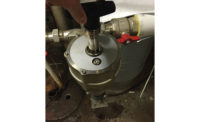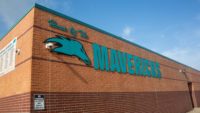It has been almost 50 years since he graduated from the University of Detroit Jesuit High School, but Mark Bobrowski continues to give back to the school he learned so much from.
Bobrowski, the senior mechanical engineer-preconstruction services at the Southfield, Mich., design-build firm John E. Green Co., has provided his skills on projects at his alma mater since the mid-1990s.
“I believe the first time I went there to work was in 1997,” he says. “I don’t know where the time went. One way or another, I’ve been involved with all the projects since then. I know the place inside and out.”
The all-boys Detroit Jesuit opened in 1877 and is a college-preparatory school that draws students from the inner-city and suburbs. Most of the campus buildings were constructed in 1930. Just before Bobrowski started working on upgrades in the 1990s, the school’s leaders considered moving it to the suburbs.
Bobrowski says the challenges ran deep when he started working on campus.
“Back then, it was in bad shape, mechanically,” he said. “Heating was from steam boilers and opening the windows was your cooling and ventilation.”
In total, Bobrowski has developed four major projects at Detroit Jesuit over the last 20 years, most recently its 40,000-square-foot building dedicated toward STEM (science, technology, engineering and mathematics).
“They decided it was time to build a new addition to house the state-of-the-art technology for the school,” he explains.
The four-story facility has laboratories dedicated for robotics, chemistry, biology, physics and general learning. It also houses the Detroit Jesuit Shell Eco-Car Program, a program that challenges students around the world to design, build and drive the most energy-efficient car in the annual Shell-Eco Marathon.
Working in the lab
After a successful partnership with Aquatherm on a direct-bury water-source heat pump pipe project on campus in 2013, Bobrowski and Aquatherm teamed up again for the STEM building. Bobrowski initially specified Aquatherm SDR 17.6 Blue Pipe for the chilled water system’s 4-in. main pipe runs that had just been added to the manufacturer’s line. Unfortunately, the initial inventory of 4-in. Blue Pipe quickly sold out and Bobrowski had to go back to the drawing board.
Bobrowski admits there was some concern that the smaller-diameter pipe would not handle the demands for the chilled-water system at Detroit Jesuit. But those fears were proven unnecessary. He and Aquatherm confirmed the manufacturer’s smaller-diameter SDR 7.4 Green Pipe — which provides LEED v4 credits — could provide the volume needed for the STEM system because the Green Pipe has a smoother finish inside, allowing for more water to glide through it, Bobrowski notes.
Bobrowski says the lightweight pipe made it easier to install and easier to assemble for this project because of the lack of welding or use of mechanical couplings.
“It all worked out,” he says. “I was a little iffy with that one, but I could see how it worked and used it on my own terms. Once we put the pipe in, it worked out well. I’ll use it again in the future.”
Bob Williams, the director of plant operations at Detroit Jesuit who works closely with Bobrowksi, signed off on the Green Pipe after the success of the 2013 water-source heat pump project and how it has aided the school in the green market, even just a little bit.
“When John E. Green wanted to bring it in on this project, I was all for it,” Williams says. “On this project, we appreciated the inherent insulating properties of the pipe and we can bill this as a green product. So even though we’re not building a totally green building, we’re able to boast a bit about what we’re doing here.”
Bobrowski and the John E. Green construction team used heat fusion to join the Green Pipe and its fittings. The elements are placed on a heating iron at 400°-500° F and then connected, eliminating systematic weakness and fail points. The heat-fused fittings maintain the same properties as the Green Pipe, so physical stresses do not compromise the pipe’s integrity. After installation, a pressure test was performed using compressed air to confirm there were no leaks.
“There’s an element of preparation that goes into every joint, but you become a student of the process,” says Josh Umphrey, John E. Green’s journeyman pipe fitter. “Toward the end, I had a good handle on what to do and how to make a perfect fusion. There’s definitely a labor savings compared to welding steel pipe.”
The domestic hot water system utilized Viega ProPress fittings on the copper pipe and on the natural-gas black pipes.
No summer break
Detroit Jesuit’s STEM building was under a construction time-crunch and had to be ready before the start of the 2016-17 school year. Construction began at the end of the 2014-15 school year, and to meet the open date, the building utilized precast concrete and some of the chilled-water pipe system was fabricated at Aquatherm’s facility in Lindon, Utah.
Bobrowski specified Armstrong Fluid Technology dualARM variable-speed pumps, which are housed in the penthouse mechanical room along with a 142-ton Daikin air-cooled scroll compressor chiller on the roof. Both the pumps and the chiller are tied to Aquatherm Green Pipe in 2-, 2 1/2, 3-, and 4-in. diameters. The dualARM pumps also are used in the hot water systems at Detroit Jesuit.
“It’s like having two pumps. They are connected together and its one pipe in and one pipe out,” he says. “They can either work as independent pumps or together. It makes for a simpler installation. That was something new I worked with.”
The Daikin air-cooled chiller is self-contained and piped up to the roof with all the controls built into the unit. There was an additional benefit provided by the precast concrete, Bobrowski reveals. It gave the STEM building thicker walls and acted as a sound insulator.
“The precast concrete absorbs the sound better and it is not as noisy,” he states. “With chillers on the roof and when the compressors are on, it’s pretty loud. The sound travels throughout the building. Here, we put it out of the way so it was not directly over any classrooms. You don’t hear it inside the building.”
The majority of the plumbing for the STEM building is made up of laboratory sinks and TOTO toilets. Detroit Jesuit and Bobrowski got an assist from another school alum that works with local rep firm Burke Agency.
“All the plumbing products were donated,” Bobrowski says. “All the toilets, sinks and faucets. All the lab faucets and air/gas turrets were alumni-donated as well.”
Learning new tricks
The majority of Bobrowski’s work is in the automotive industry around the Detroit region. Those companies, according to him, usually stick with tried-and-true designs. On top of having the chance to help his former school, receiving the opportunity to design a system completely different from what he typically does was appealing.
“It was a good deal for Detroit Jesuit and a good experience for John E. Green to get on board,” Bobrowski says. “Since I did the design and we’re the engineer of record, it was an opportunity for John E. Green and our people to get involved with a great new product. You have to capitalize on those opportunities when they arise.”
Designing school laboratories proved to be an interesting challenge for Bobrowski, mainly because there are various levels of lab design. The levels range from professional to high school where product selection is key. Working within the school’s budget, Bobrowski designed a premier high-school-level lab at Detroit Jesuit.
“We came up with a way to properly pressurize the labs and we did it within the HVAC controls system,” he notes. “We used more standard items than specialized products to accomplish the same goal.”
Bobrowksi notes each lab has a pressure-control monitor and the variable-air-volume HVAC system was set up so the rooms had negative pressure.
“We pulled more air out of the rooms than what we were putting into them,” he says. “That was to keep the negative pressure. It was a high-school-grade lab system that works as well as anything else that didn’t use the high-priced equipment to accomplish that. We had to battle with everyone to buy into it. That was the hardest thing. A lot of people doubted we could do it, but we proved we could do it.”
Bobrowski wanted to provide a world-class system and STEM facility to Detroit Jesuit — and not just for his former school.
“They do well and it’s in the city of Detroit,” he notes. “They could’ve moved out to the suburbs many years ago, but they stayed. It’s a great outcome for everyone.
“I donated my time to do some engineering there. In the end, it’s the best bang for the buck and they have a lot of neat stuff in there that works really well. We’ve watched the systems operate and they do what they are supposed to. That’s the best part for me — designing something that works and is cost-effective. Maybe it is something they’ll have for the next 100 years.”
This article was originally titled “Piping in results” in the July 2017 print edition of PM Engineer.










